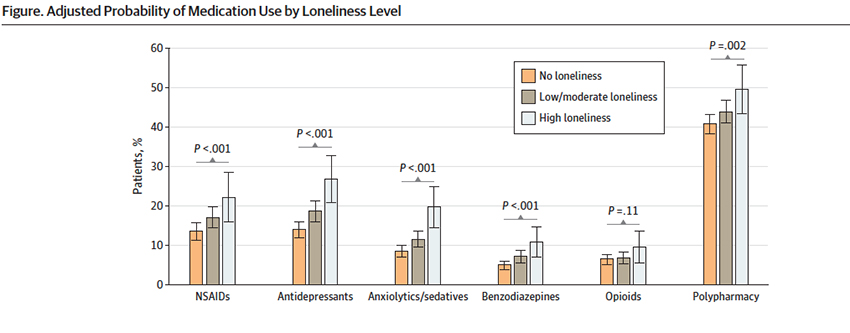For geriatric patients, an increasingly larger proportion of our population, loneliness is problematic. Friends and family die; you don’t necessarily get around as well – your life space contracts. This is also the population that requires several medications to keep ticking; many experience polypharmacy, a large number of daily pills. Of course, with more medicines, there are more interactions between them, so deprescribing and reducing medication overload is a worthwhile goal. With this as a preamble, let’s consider the study.
The researcher made use of the National Social Life, Health, and Aging Project (NSHAP), a series of national surveys of community-living adults over age 65. (My peeps) Overall, the study considered roughly 6,000 respondents who self-described their loneliness from none, to low/moderate to high. Their medications were identified as in-person interviews and categorized by a pharmacist.
Fifty-four percent were women, mean age 73, and predominantly white, 84%. 40% were low to moderately lonely, 7% were highly lonely. There was a statistically significant step-wise increase in pain, insomnia, depression, and anxiety with increasing loneliness. There was a similar statistically significant step-wise increase in medications, specifically non-steroid anti-inflammatories, benzodiazepines, anxiolytics/sedatives, and anti-depressants. Opioid use did increase with loneliness but failed to reach their p-value of 0.001. Roughly 50% in each category of loneliness had multi co-morbidities resulting in polypharmacy – taking more than five or more different medications daily. (It ain’t easy getting old, it is not for the weak)

The researchers freely acknowledge the limitation of the study.
“A primary limitation of this study is the cross-sectional analysis, which limits our ability to draw causal conclusions on the directionality of our findings.”
Which does come first, the symptoms or the medication? The study does not report on all the medications these patients were taking; they might well have shown similar results for beta-blockers or anti-coagulants – medicines popular in this age group. They restricted their study to medications associated with loneliness, and to most clinicians, the results are not surprising. They suggest that “clinicians should consider initiating social interventions for lonely older adults or ‘social prescribing.’” In a perfect world where patient throughput was not the outcome measure rewarding care that might be valuable, they have not made a case for that recommendation based on this study.
Source: LESS IS MORE Use of High-risk Medications Among Lonely Older Adults: Results From a Nationally Representative Sample JAMA Internal Medicine DOI: 10.1001/jamainternmed.2021.3775" Please note that LESS IS MORE, an editorial comment if I have ever seen one, appears to have been added by the editors, not the authors.




